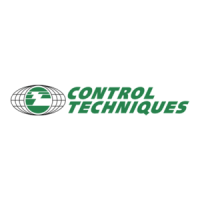150
FM-3 Programming Module Reference Manual
3 = Drive power module fault
4 = Low DC bus fault
5 = High DC bus fault
8 = Drive internal fault 1
9 = Drive trajectory fault
10 = Drive internal fault 2
16 = Drive watchdog timer fault
19 = Drive over speed fault
21 = Drive power up self test fault
20 = Drive invalid configuration fault
24 = Drive RMS shunt power fault
25 = Motor overtemperature fault
All other bits are not used. A "1" in these bit locations indicates the specific fault is active,
and a "0" is inactive.
Drive OK
Fault.DriveOK
Active when there are no faults. Inactivated when any fault except travel limits occur. Drive
enable has no effect on this event.
Faulted
Fault.Faulted
Any fault will activate this event.
Module Faults Bitmap
Fault.ModuleFaultsBitmap
This parameter is a 32-bit register which holds all of the module fault status bits. Following
is a list of all module faults and their associated bit numbers:
0 = Module watchdog timer fault
1 = Module invalid configuration fault
2 = Module NVM invalid fault
3 = Module power up self test fault
4 = Module following error fault

